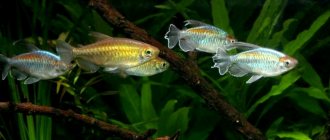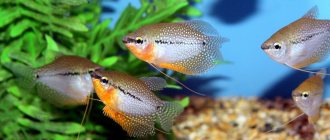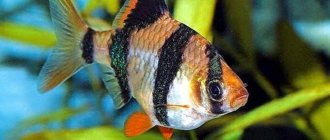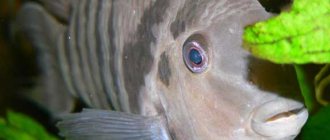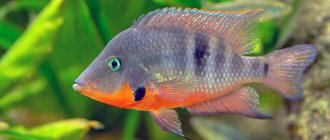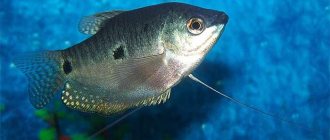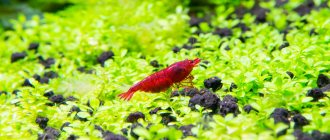Who do betta fish get along with in a community aquarium?
Today, bettas (lat. Betta splendens) are popular aquarium fish. They belong to the Macropod family, suborder Labyrinth fish. Cockerels have a cocky character, for which they are nicknamed “fighting fish.” They do not always tolerate settlements with other fish; it is difficult for them to live with neighbors due to their pugnacity. If you place a male betta in the same aquarium with another betta, then conflicts will arise between them, which will end in bodily harm and plucked fins.
But this does not mean at all that they cannot be housed with fish. On the contrary, a good neighborhood harmonizes life in the aquarium. If your tank is spacious, has a beautiful aquascape created in it, reminiscent of a natural biotope, there are a lot of plants, shelters, and a biological balance has been established - then all the inhabitants will be comfortable. An important rule is that you cannot have more than one male betta living within the same aquarium. They cannot be called territorial fish, but it so happens that they will fight. You can house several females for one male, so he will be comfortable.
Female Betta splendens are smaller in size, their fins are shorter, and their character is calmer. But females can also conflict both with each other and with the male. Females can be kept in one nursery of 3-4 individuals. They are less aggressive, but their character is also unpredictable. If you notice that betta fish are constantly aggressive towards their neighbors, and this leads to fatal consequences, then do not spare money for another tank, placing a restless pet in it.
Rules for keeping Betta splendens in a common tank
These fish tolerate temperature changes well and can thrive at temperatures of +18 and +25 degrees Celsius. But sudden changes should not be allowed, as they are harmful to the pet’s health. Like a labyrinth fish, the betta should live in water that corresponds to the ambient air temperature in the room: +22-26 degrees. Due to the fact that he can breathe with a labyrinth organ, aeration is not necessary - this should be taken into account when introducing other fish that cannot live without dissolved oxygen. The water must be replaced once a week, 20% of the total volume of the tank. Don't forget to clean the bottom of food debris and dirt.
What rules must be followed so that bettas can live peacefully in an aquarium with other fish? These rules apply to all cockerels, thanks to which peaceful cohabitation with representatives of different species of fish can be achieved.
- It is not recommended to keep fish with long fins and brightly colored scales with bettas. Although the cockerels themselves are distinguished by their beautiful appearance, they are sensitive to “competitors” who are like external irritants for them.
- You cannot house cockerels with large and predatory fish, for example, African and South American cichlids. The latter themselves are peaceful and friendly creatures, but they do not get along with fighting fish.
- Try to keep your fish in water that is suitable for everyone. It is impossible to settle heat-loving species and cold-loving ones. For example, goldfish cannot live in warm water, so they are incompatible with betta fish.
- Betta splendens fish can be housed with speckled catfish, tetras, gouramis, swordtails, and mollies. After settling the fish in the aquarium, observe their behavior. You can also keep the fish together from a young age, so they will get used to each other better. Fish should not be less than 5 cm in length. If your neighbor's fish has died, do not add a new fish to the cockerel, otherwise he will kill it.
- Compatibility with other fish will be successful if the betta lives in a spacious tank of 50-100 liters. You can put a lot of decor and shelters there, which will nullify territorial claims and conflicts.
Take a look at a community aquarium with bettas.
There are aquarium fish with which bettas are well compatible; they live peacefully, with periodic fights that do not lead to death. These fish include marbled gourami, cardinals, labeo, lalius, macrognathus, and angelfish. But it should be taken into account that during the first days of settlement it is necessary to monitor their reaction; in case of aggression, they are settled separately from each other.
The fish Betta splendens has almost perfect compatibility with platies, iridescents, black mollies, ornathuses, grumbling gouramis, acanthophthalmus, befortia, ancistrus, minors, otocincles, rasboras, thorns, congos, botias, tarakatums, loricarias, Siamese gastromyzons, brocade catfishes.
Description of compatibility with certain fish species
Neighborhood Rules
To prevent fish from biting the fins of their neighbors, they must be kept in schools. Species are traditionally divided according to size. Large ones are those that grow to 10-12 cm and above. They get along well with cichlids and catfish.
It is important not to plant barbs with fish that have veil fins. The antennae fins of lalius and gourami will also not last long. Robbers will deprive elegant fish of their beautiful “plumage” and ruin their appearance.
Barbs look very impressive in the company of their own kind.
Most often, a separate aquarium is allocated for robbers - a species one - or flocks of different barbs are combined so that they play with each other. After all, if for representatives of the carp family, plucking fins is fun, then for their neighbors it is fear, shock, and stress. Therefore, it is important for them to select a “company” very carefully, scrupulously.
Their neighbors may be fish, who can stand up for themselves. These, for example, include:
- swordtails
- clowns
- battles
- platies
- labeo
- mollies
- iris
- catfish
- tetras
- corridors
With such roommates they will look good in color and live peacefully.
Compatibility table for barbs with other fish.
These bullies can also coexist with cockerels without loss. But then the aquarist’s special task will be to maintain a comfortable water temperature. Otherwise, the former may freeze, and the latter may overheat.
It is advisable to introduce barbs already when the other fish in the aquarium have become accustomed, so that some kind of ghetto does not arise from where bullies will drive out peaceful neighbors. If someone has offspring, then it is useless to hope to save them. Everyone will be eaten.
To prevent barbs from attacking anyone, they need a large enough aquarium so that there is enough space for everyone. It is also important to feed everyone well so that there is no competition. If the fish’s fins have already been “chopped off”, then, most likely, they will not leave it alone and it is better to put it in another place so that they do not completely destroy it.
It is best to place barbs of different species in the same aquarium with other fish, then they will sort out relationships among themselves without disturbing their neighbors.
Barbs and shrimps
They must not be combined under any circumstances! Shrimp have a small chance to survive only if Java moss is planted at the bottom, otherwise... After breakfast and lunch, barbs recheck every grain of sand in search of food. Shrimp are a wonderful delicacy for them.
True, if there is a good flow in the aquarium and there are a lot of plants, then you can try planting them together. However, this is more of a lottery than a proper neighborhood.
06:26
MACROBRACHIUM SHRIMP FIGHTS AWAY FROM BARBS
08:24
What fish do cherry shrimp get along with, CHERRY!?!(Neocaridina Heteropoda var. Red)
Barbs and crayfish
These pets are “multi-level”, that is, they live in different layers of water. In addition, the fish are very playful, and here you need to worry about both crayfish and barbs. In general, they do not conflict, but if they cross, dangerous situations can occur. A barb that is gaping in the area of action of the crayfish runs the risk of being caught in its tenacious claws. Cancer, in turn, becomes defenseless after molting, until the shell has regained its former density.
Barbs and snails
In this case, opinions differ: some fans claim that the fish eat up the inhabitants of the shells completely and mercilessly. Others note their peaceful proximity. On the one hand, barbs can destroy the reel population. On the other hand, even ampullaria often suffer from these aggressors. There is an opinion that if there is abundant vegetation in the aquarium, snails manage to survive successfully.
Plants
There should be a lot of vegetation in an aquarium with these fish. But they like to pluck “tender” plants because of their temperament, that is, just like that. Some aquarists, so that the plants have time to produce at least small shoots, throw a lettuce leaf into the aquarium to calm the pets’ appetite.
Tender plants include:
- Vallisneria
- cabomba carolina
- water cabomba
- cabomba forked
- limnophils (ambulia)
Barbs of any type should be kept in a planted aquarium. Live ones are preferred, but plastic ones can also be used.
It is better to plant hard-leaved ones with barbs, for example:
- anubias
- cryptocoryne
- fern
They do not like such plants and consider them tasteless. In addition, they are difficult to chew.
Cockerel in an aquarium
The betta fish creates incredible beauty in the aquarium and is known to everyone for its fighting qualities. He oppresses the female and males similar to himself. This is a typical labyrinth fish that is able to breathe atmospheric oxygen. The cockerel gained its popularity for its restless character, chic appearance and ability to live in a small body of water. The cockerel has many color options and different shapes of elegant fins.
Who does a cockerel get along with in an aquarium?
Keeping a betta in an aquarium
This fish is quite easy to care for. One specimen requires an aquarium of at least 5 liters. There should be places on the surface of the water that are not covered by floating plants, since the inhabitant floats to the surface to take a sip of atmospheric air. Therefore, such fish do not need additional aeration.
The tank must be covered with an equipped lid or glass. A fighter can jump out of it or simply catch a cold, as he often floats to the surface.
A filter for a small-volume vessel will not hurt a fighter, but is not required for maintenance.
The acceptable temperature for a betta in an aquarium is 26-30 degrees. Short-term deviations within 18-36 marks are allowed. But if left for more than three days at an unacceptable temperature, the fish may become ill and die. Therefore, the tank for the betta must be equipped with a thermostat and a thermometer.
For impeccable maintenance and achieving biobalance in the tank, you need to have live plants and provide them with lighting. It is imperative to change the water weekly in an amount of 40% of the volume. The cockerel's water should be clean and fresh; the individual is not picky about the composition of the water.
The cockerel is not picky about food and can eat live and frozen food. My favorite is bloodworm. You need to feed him once a day, it is advisable not to overfeed him. The fish must eat the food within 15 minutes, this is how the amount of food is calculated. To maintain the health and coloration of the fish at the proper level, it is recommended to alternate different types of food.
To reproduce, the male and female are placed in a spawning tank - a separate vessel. The female cockerel is slightly smaller and does not have such a bright color. During spawning, the male collects eggs in a nest that he built himself. After spawning, it is better to remove the female from him, as he can be extremely aggressive. The cockerel takes care of the eggs himself. After the larvae begin to swim, it is better to remove the male from the spawning area. Next, you should feed the fry microworm and egg yolk and monitor their growth to avoid fights.
By observing such simple conditions, you can provide comfortable living conditions for the betta fish. She will delight the breeder with her cheerful disposition and beauty.
Aquarium fish betta - maintenance, care and compatibility with other fish
The betta fish, or betta fish as it is also called, is a member of the labyrinthine family. This name for this species is not accidental. The bright color, as well as the warlike character of the “fighters” in some way resembles the same cocky and beautiful “earthly” roosters. If two males are placed in one aquarium, a real cockfight can begin with their tails and fins spread out. You need to quickly separate the fighters, otherwise one of them will die. Cockfighting is extremely popular in their homeland.
Origin
The betta fish has its origins in Thailand, Indonesia and Vietnam. There, these aquatic inhabitants live in small warm ponds. Therefore, the optimal water temperature for this species is 22-26 degrees. The silty, standing waters of Southeast Asia are low in oxygen. Therefore, your aquarium will not need an aerator to saturate the water with oxygen.
At home, no one is particularly interested in what color the betta fish is. Their content boils down to preparation for battles. Special trainers do this. A huge number of spectators come to watch the fights. However, most often the death of the fish is not allowed; torn fins are enough.
Description
The betta fish has an oval, elongated body, slightly compressed at the sides. Its length is up to 5 cm in males and smaller, up to 4 cm, in females. In terms of beauty and brightness, the “fabulousness” of coloring, they have no equal. At any turn, red, yellow, orange, pink, green colors sparkle and play, taking on all sorts of shades. The color of males is especially bright when they clash with each other.
During spawning, the betta fish also “fills up” with paint. The females are a little paler than their gentlemen; the fins of the “ladies” are short and not so luxurious. However, breeders are working in this direction. Not so long ago, females appeared whose fins have a more elongated shape, and the body color is not inferior to males.
The betta fish has dark stripes across or along its body. The upper fin and tail of this species are rounded, the lower fin, starting from the head, reaches the tail. The pectoral fins of bettas have a pointed shape. It is interesting to watch fish that are excited - the gills of males swell, forming a protruding “collar” around the head.
The sex differences in these fish are obvious. The “boy” cockerel is slimmer, it is brighter in color, and its fins are much longer. Females are usually smaller and have shorter fins. The main difference between a “hen” and a cockerel will be the presence of a small white spot near the anus of a female individual - a “grain”. This formation is a bit like an “egg” coming out. It becomes clearly visible from the age of three months.
What else do you need to know after you have betta fish in your home? Maintaining them is not such a difficult task.
Content
You don't need academic knowledge or special conditions to own a betta fish. This species feels great even in a small aquarium. Some owners manage to keep one individual in an ordinary three-liter jar. But two males cannot get along in one “reservoir”. True, some owners separate long aquariums with glass, placing their pets one at a time in different compartments. Many people also do this because, seeing an opponent, the cockerels begin to become brighter, more colorful, they take warlike poses, trying to frighten and intimidate their counterpart. Females are not so aggressive; several of them can be kept at a time.
Betta fish at home can live in an aquarium at the same time as other species. However, it is worth avoiding neighbors with veil fins. Otherwise, the “fighters” will certainly cut them off. It is better to place larger fish with short fins, such as barbs, with the cockerels.
For tropical bettas, it is advisable to maintain the water temperature in the range of 24 to 28 degrees. It is allowed to periodically reduce it to 18 degrees. Open areas should be left on the surface of the water, without floating vegetation. Fish need atmospheric air. There is no need for special aeration of the water, but it is advisable to pass the water through a filter. It is recommended to place the aquarium in such a way that it receives sunlight for several hours during the day. It is not advisable to place it in a draft.
The pond should be thoroughly cleaned periodically. To do this, you should either partially or completely change the water. The fish are first caught with a special net and placed in a jar. Sanitation is carried out without the use of powders.
Air
The labyrinth organ is a distinctive feature of betta fish. This is not a simple addition to the gills - these babies breathe atmospheric air. Make sure that the surface of the water does not become overgrown. Sometimes a bacterial film appears on it; it can be easily removed if you apply a sheet of paper to the water, and then simply carefully remove it.
Cockerels can jump out a lot. To prevent them from harming themselves, install a special cover with holes or a mesh.
Water
The fish will need soft water. Do not use distillate for the aquarium, as it contains not only harmful, but also beneficial substances. Specialized stores sell special preparations for softening and purifying water. Temperature should be controlled. To slightly reduce aggression and stress, add a little therapeutic and prophylactic salt (half a teaspoon per four liters). Large aquariums need water changes every two weeks. In the meantime, it is necessary to partially change it. Small aquariums need to be cleaned and water changed twice a week. Be sure to remove the remaining food from the bottom - its decomposition products will poison the water.
Feeding
What to feed betta fish? These aquatic inhabitants are not picky. They can eat both dry food and live food. Most of all, cockerels love bloodworms. You can give tubifex, cyclops, daphnia. Earthworms will do. To prevent the fish from overeating, remove uneaten leftovers 15 minutes after the start of feeding. Food should be given once or twice a day.
If you see that your pets are overeating, give them one fasting day a week.
Betta fish: compatibility
As stated earlier, male bettas should not be kept together. It is also undesirable to keep individuals of different sexes together. The male will constantly chase and bully the female.
Is this the first time a betta fish has appeared in your home? “Who does this species get along with?” - This is a question often asked by beginners. Despite their “fighting” glory, the cockerels behave quite peacefully towards their neighbors. Sometimes, however, a male can attack a male guppy, mistaking him for a relative.
It is not advisable to place a cockerel with those with beautiful long fins and tails. This will definitely provoke the betta fish and it will start attacking. It is unlikely that a cockerel will bring its opponent to death, but it can bite or tear off tails and fins.
Often, aquarium owners add snails to their pets. Betta fish can feed on small specimens (this is why they are usually planted). In larger individuals, cockerels may bite the antennae. Those who plan to decorate their aquarium with large snails should keep this in mind.
Suitable neighbors for betta fish
What fish do bettas get along with? These can be neon irises, swordtails, platies, ancitruses, brocade catfishes, cockroaches, loaches, grunting gourami, acanthophthalmus, pulchrypinnis, speckled catfish, gastromyzons and some other species. It is advisable to consult with a sales consultant before purchasing fish.
Unwanted neighbors for cockerels
Acaras, piranhas, tilapias, black-striped cichlosomas, ctenopomas, tetraodons, parrots, cupanuses, astronotuses - cockerels cannot be housed with these types of fish. Fighters can attack and tear off the fins of such neighbors as neons, danios, guppies, cardinals, barbs, as well as spotted, pearl and marbled gouramis.
Reproduction of betta fish
Spawning should be carried out in a small separate aquarium (from seven liters). The height of the water column should be approximately 10-15 cm. Shelters from aquarium plants and artificial grottoes are arranged here. The betta fish (female) will be able to hide here from the male, who is very aggressive during this period.
Breeders should be fed with all kinds of live food before spawning. You don't need bright light. Aeration should not be done in a spawning aquarium - it will interfere with the construction of the nest.
Sexual maturity in fighting fish occurs at three to four months. You can stimulate spawning with a large water change. It is heated in the aquarium by 1-3 degrees. First, the fish are “introduced” to each other. To do this, they are placed in adjacent containers so that they can see their neighbors.
Small floating plants are added for the male to strengthen the nest. At the beginning of spawning, starting to build a “dwelling,” the male cockerel releases small air bubbles, then gluing them together with his saliva. About a day after the manufacturer is launched, the expectant mother is placed with him. After the start of spawning, the male cockerel collects the eggs with his mouth and carries them to the nest.
At the end of the spawn, he becomes aggressive and attacks the female. Therefore, it should be removed to another aquarium. The male raises the offspring - he guards the nest, picks up the eggs that fall out, and places them back. After the larvae hatch, the cockerel prevents them from spreading out in different directions, collecting them.
The female is capable of laying 100-300 eggs at a time. Under normal conditions, spawning begins a day or two after a pair of bettas are placed together in the aquarium. It happens, however, that this process drags on for a week. After a day or three, larvae appear in the aquarium. After all the fry appear, and this will happen in 4-6 days, the male is removed, otherwise he is able to crush the fry spreading in different directions. In a spawning aquarium, a betta is usually fed bloodworms. The food must be washed well beforehand.
In young cockerels, the labyrinth organ will appear only after a few months. To create good conditions for growing young animals, it is necessary to install aeration. You can lower the water level.
The fry are fed with ciliates - “living dust”. In exceptional cases, you can give hard-boiled egg yolk. However, you should not abuse such complementary foods. When the young animals grow up, you can switch them to feeding Artemia larvae. Next, the size of the feed is selected taking into account the size of the fry. You can introduce chopped tubifex or specially developed industrial feed into the diet.
Betta fish live for about three years. At an “old” age, it is undesirable to use them as producers.
Summing up
Bright and eccentric cockerels can decorate any home or office. Caring for them is easy. In return, they will give their owner many pleasant moments.
fb.ru>
How many years will a betta live in an aquarium?
How to choose a healthy betta in the store?
Your betta will live longer if purchased from a good seller in the first place. When you notice that the fish lives in high-quality conditions, moves well, eats, and has a beautiful appearance, it means you can put it in your home. First of all, pay attention to the activity of the fish in the aquarium, the condition of the scales and fins, and its general physical condition.
Buy a young fish. The sooner she gets used to your aquarium, the more comfortable she will be there. Young animals quickly adapt to new living conditions. Young cockerels have shorter fins than mature ones, and young ones have body sizes that are several centimeters smaller.
Check out the young male Blue/Red Dragon Halfmoon Betta.
Assess the volume and condition of the water in which the not yet purchased fish lives. If you notice cloudiness, dirt, or a substrate of unknown origin, hold off on purchasing. The water should be clean, transparent, a slightly yellowish tint is allowed.
Look at other fish that live in the same tank as the fish you like. Isn't their capacity too small? How do they move, feed, their external condition? Siamese bettas are fighters, and long-term placement in a species aquarium will destroy them all. If each fish lives separately, in good conditions, this is a big plus.
Do not buy two Betta splendens fish at once. If you put newcomers in a common tank, they will quickly harm each other. Buy one pet, quarantine it for 2 weeks, look at its condition. When he gets used to the new environment, you can move him into a previously prepared aquarium. After a few months, you can move neighbors in with him, but given his personality traits, this is a big risk.
How to help your fish live longer?
- Set up the aquarium correctly, wait until biological equilibrium is established in it. Let it be a rectangular tank with a volume of 50-100 liters. Small, round containers will not allow the fish to move from its place; it will be uncomfortable and bored. In the spacious tank it is possible to create an amazing aquascape reminiscent of a natural biotope. Use a good filter so that it quickly copes with the biological load.
- Let your aquarium have plants and algae. Most betta-friendly tanks have plenty of vegetation to ensure the water has enough oxygen to keep it clean. Buy plants from trusted sellers to ensure they are healthy and free of pests.
- Maintain the temperature in the aquarium.
Adjust it using a water thermometer. The cockerel is a tropical fish that is accustomed to warm water: a temperature of 26-29°C is its limit. Use heating devices with a power of 50 W. See how to keep a betta fish. - The life of the fish will be extended by proper, balanced feeding. In an aquarium, a fish will only eat what is given to it, so choose several types of food. Live, frozen, dry, artificial - the betta is omnivorous. However, you should not overfeed; try to give suitable, proven food. Remove uneaten food scraps promptly.
- Be attentive to your pet - watch him, play with him. Teach him new tricks that will help him interact with you.
- Do not try to provoke the fish into aggression. Sometimes you can put a mirror in the aquarium, but for a short time. The Betta is a real fighter, so he shouldn't be in a constant rage. Do not place decorations or stones at the bottom of the tank, which may affect the quality of the water. Dyes and water softeners are not always appropriate.
- Change the water and clean your aquarium in a timely manner. There is an opinion that bettas are very hardy fish, but this is not entirely true. Dirty water can cause illness and even death of your pet. Sudden changes in water parameters are also detrimental to living beings.
- Let the fish spawn. Even if cockerels are not good parents, the lack of reproduction has a negative impact on their health. In the female, delayed eggs form cysts, which are difficult for her to live with. Males become more lethargic and live shorter lives.
- Make sure that the lid of the aquarium is slightly open. Like labyrinth fish, bettas must also breathe atmospheric air. Make sure that the air and water temperatures match.
General principles for keeping betta fish with other fish species
- It is necessary to limit proximity to species with brightly colored bodies. There is a possibility that the cockerels will incite conflict.
- Do not release them into an aquarium with predatory animals. This can be dangerous for betta fish.
- The temperature range of the tank must be uniform. Some fish species cannot live with bettas because they cannot tolerate warm water.
- If you plan to live next to other inhabitants, you need to equip the aquarium with plants and decorative elements. The fish will find shelter and conflict situations will rarely arise.
Previous
FishReal aquarium shark and keeping shark catfish in an aquarium
Next
FishFish with big bulging eyes - this is about telescopes
Choosing an aquarium for betta fish
Many cockerels are sold in pet stores, where they are housed in small glass jars. Is it right to keep fish in such conditions? Of course, this is not advisable. Despite the endurance of the fish, aquariums for bettas should be spacious enough for free movement. These fish will show their color as brightly as possible and straighten their fins if they live in a comfortable environment. It is important that your betta fish can easily turn around in the tank without limiting their movements. Moreover, it is impossible to place plants, decorations, or a filter in a cramped container.
Improper housing leads to pet diseases and other negative consequences. Sometimes the jars where the cockerels were kept could contain medications (methylene blue), but there was no heating at all. In general, fish simply will not survive if their space is limited. Where can they be placed?
What aquariums are suitable for milking bettas?
Of course, aquarium fish cannot live in a glass of water or in a 1.5-liter jar. The average size of cockerels is 5-6 cm, so they require a little space, but with room for free movement. If you can’t purchase an aquarium, you can place your pet in a 3-5 liter jar of infused water for a while. Oddly enough, you can place some decorations or plants in it. However, the betta is not a Spartan, so the best conditions for it are special aquariums for bettas. It will be pleasant to watch the fish through the decorative tank, where it can quickly get used to it and even produce offspring.
Look at what aquariums there are for keeping cockerels.
A 20 liter rectangular aquarium may be simple in appearance, but it is better suited for fish than a glass jar. Betta fish can calmly turn around in it and enjoy the scenery; in such a tank it is possible to maintain stable water parameters. It will not overheat too much, maintaining a stable biobalance. In a 20-liter aquarium it is easy to create an aquascape with decorations, plants, driftwood and stones. You can even throw not one, but two fish into it.
10-liter rectangular - if you do not yet have the opportunity to buy a 20-liter aquarium, take a smaller tank. This is the minimum allowable volume for keeping one adult rooster. However, maintaining the balance of the aquatic environment here is much more difficult; it will quickly become polluted and heat up.
Aquarium for bettas is round - there is an opinion that many bettas finished their best years in round containers, but this is not entirely true. Round tanks are a good place to keep your pet in quarantine until she gets used to her new environment. Round containers serve as good carriers for fish; you can install small decorations and even a filter in them. It is more difficult to remove such a structure - a regular scraper will not cope with algae settled on the glass. A brush won't help. It is believed that tanks of this shape have a bad effect on the vision of bettas; they distort its appearance from an optical point of view. Of course, you can choose such an aquarium, but rectangular shapes are much better and more practical. They are easier to maintain.
Look at the original idea of keeping bettas.
Are there special aquariums for bettas?
For a 5-centimeter fish, a well-decorated tank is suitable. You want your fish to have a full life, right? Then take into account the fact that the optimal aquarium for a betta is one made in production. Many companies offer aquariums for betta fish in round, rectangular, even square shapes. They are immediately equipped with a lamp, lamp, decor, and filter. Another thing is that cockerels do not need constant lighting, so the lamp does not need to be kept on all the time. Algae love light, but why do you need the extra hassle of cleaning?
Try buying a simple 20-50 liter rectangular tank with a filter and lamp. You can install decorations, soil, and shelters yourself if you know how to handle them correctly. Before placing the fish, rinse the glass container under running water and treat it with baking soda, rinsing it 4 times. It follows from this that the best house for a betta fish is a classic rectangular one, which has everything to recreate a natural biotope.
Type of aquarium fish and compatibility of different species (table)
Species compatibility
Goldfish
Another pet for beginners is goldfish. Aquarium species of these fish are very common. If you look at the compatibility chart, the line dedicated to goldfish will be completely filled with red, with a few yellow areas, just like many cichlids. But if cichlids are aggressive, then goldfish themselves often become victims. Goldfish are large, and they will gradually eat small things like rasboras and neons. And other inhabitants of the aquarium themselves can offend the slow and gentle goldfish with long fins.
It is best to keep goldfish with their own kind; there are quite a few interesting varieties of this breed. At the same time, do not forget that if you want to produce offspring, then you cannot keep different species together. Who can goldfish get along with? Aquarium species of calm catfish - cockroaches, clown loaches, corydoras, peaceful tetras - congo, thornets and calm danios are quite suitable. There are also examples of successful cohabitation of goldfish with neons, angelfish, and viviparous fish, but one must remember that any proximity of goldfish with other species can result in conflicts and death of the inhabitants of the aquarium.
Soma
Cichlids
Viviparous
Labyrinthine
Characinaceae
Botsiya
Barbs
Danio
Labeo
Compatibility with other aquarium inhabitants
- Shrimps. It is better not to keep shrimp and barbs together. If the shrimp are small, the barbs will destroy them, but if the shrimp are large, they themselves will pose a danger to the small bullies.
- Turtles . Turtles are not dangerous for barbs only at a very young age. Grown-up individuals are extremely dangerous and can quickly exterminate the entire flock.
- Axolotl . Axolotls are too gentle and introverted creatures; they should absolutely not be housed with barbs. They will be offended and eat their fins.
Finding suitable neighbors for Sumatran barbs is not a very difficult task. However, most often - for variety - simply different varieties are planted in aquariums at the same time. Sumatran, fiery, cherry and green barbs get along very well together.
- Related Posts
- Odessa or Scarlet Barb
- Veiled fire barb: maintenance rules
- Breeding Sumatran barbs



